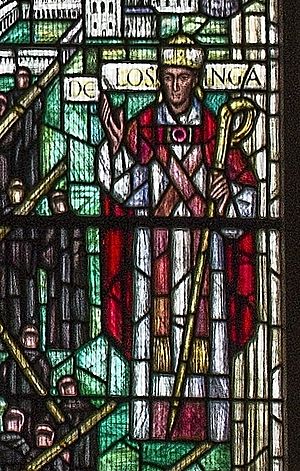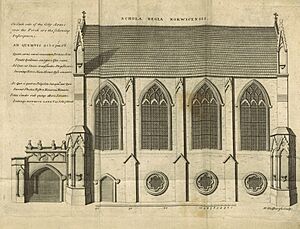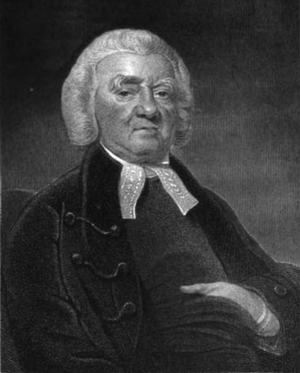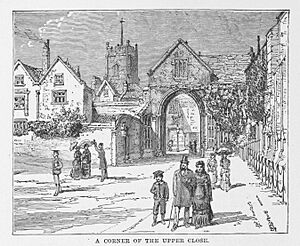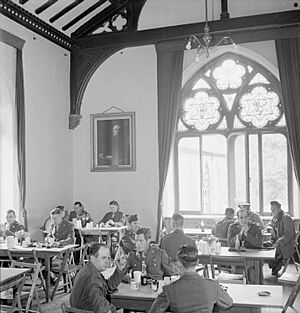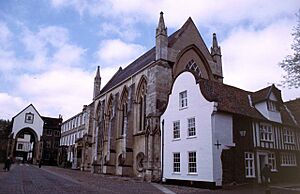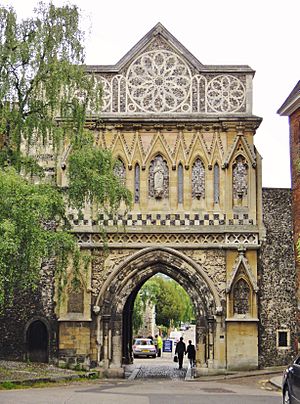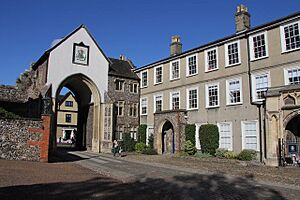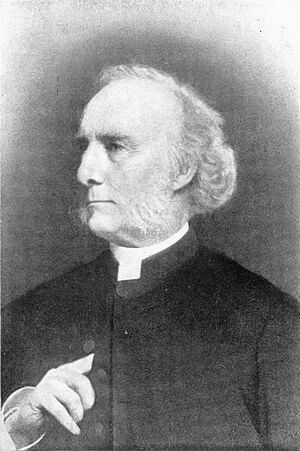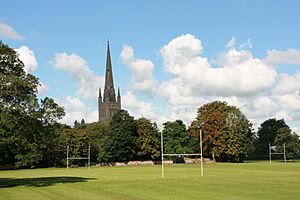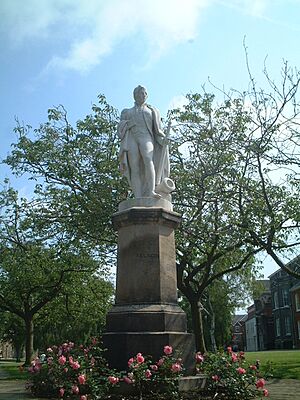Norwich School facts for kids
Quick facts for kids Norwich School |
|
|---|---|
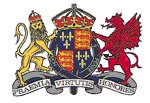 |
|
| Address | |
|
70 The Close
, , NR1 4DD
England
|
|
| Coordinates | 52°37′54″N 1°17′57″E / 52.6318°N 1.2993°E |
| Information | |
| Type | Private day school Public school |
| Motto | Praemia Virtutis Honores (Honours are the rewards of virtue) |
| Religious affiliation(s) | Church of England |
| Established | 1096 1547 (Refoundation) |
| Founders | |
| Department for Education URN | 121242 Tables |
| Chairman of the governors | P. J. E. Smith |
| Head master | Steffan Griffiths |
| Staff | 140 (full-time) |
| Gender | Co-educational |
| Age | 4 to 18 |
| Enrolment | 1,069 |
| Houses | Brooke, Coke, Seagrim, Nelson, Parker, Repton, School, Valpy |
| Colour(s) | Royal blue and burgundy |
| Publication | The Norvicensian Old Norvicensian The Longbow |
| Alumni | Old Norvicensians ("ONs") |
| Affiliations | Worshipful Company of Dyers HMC, CSA, IAPS |
Norwich School is a private day school located near Norwich Cathedral in England. It is one of the oldest schools in the United Kingdom. Its history goes all the way back to 1096. That's when Herbert de Losinga, the first Bishop of Norwich, started a grammar school.
In the 1500s, the school became part of the city of Norwich. It moved to its current spot next to the cathedral in 1551. King Edward VI officially re-established the school in 1547.
For most of its history, Norwich School was only for boys. Girls started joining the older classes (sixth form) in 1994. By 2010, girls could join all age groups. Today, the school has about 1,020 students.
The school is split into two parts. The Senior School is for students aged 11 to 18. The Lower School is for younger students, aged 4 to 11. The school works closely with Norwich Cathedral. Students often have morning assemblies and other events there.
Many famous people have attended Norwich School. These include Lord Nelson and Sir Edward Coke. The school is known for its strong academic results. It is often ranked as one of the best schools in Norfolk and Suffolk.
Contents
School History
How the School Started
Norwich School began in 1096. It was founded by Herbert de Losinga, the first Bishop of Norwich. This makes it one of the oldest schools still running in the UK. The school was first located near Norwich Cathedral and the River Wensum.
Before the English Reformation, the bishop chose the headteacher. The first known headteacher was Vincent of Scarning in 1240.
In 1538, King Henry VIII allowed the city of Norwich to take control of the school. It moved to Blackfriars' Hall in 1541. There, it taught 20 boys.
The 1500s and 1600s
The school was officially re-established by King Edward VI in 1547. It was then called King Edward VI Grammar School. In 1550, the city bought a former chapel next to the cathedral. The school moved there in 1551. This building is still used as the school chapel today.
The school's rules in 1566 said it should teach 90 sons of Norwich citizens for free. It could also have up to ten students who paid fees. Teachers had to know Latin and Greek very well. The main goal was for students to learn to write and speak well by age 18. They studied famous works by Homer and Virgil.
Edward Coke, a famous judge, studied at the school from 1560 to 1567. He learned to value "freedom of speech" there. This was something he used later in his career.
When a new mayor of Norwich was chosen, the head boy would give a speech in Latin. This was a tradition. Queen Elizabeth I visited Norwich in 1578. The headteacher gave a speech that she loved.
The 1700s and 1800s
The way students were taught stayed mostly the same until the late 1700s. Samuel Parr was headteacher from 1778 to 1785. He was known for being very strict.
In the early 1800s, John Crome, a famous landscape painter, became a drawing teacher at the school. He founded the Norwich School of painters. This was the first art movement outside of London. Many artists from this movement studied at Norwich School. These included John Sell Cotman and James Stark.
The number of students changed a lot in the 1800s. It went from over 100 to as few as eight in 1811. Under Edward Valpy (1810–1829), student numbers grew again. In 1837, the school became independent from the city. It got its own money and a Board of Governors.
In the mid-1800s, the school changed a lot under Augustus Jessopp (1859–1879). He wanted to make it more like a modern public school. The subjects taught expanded beyond just classical languages. They added maths, drawing, German, and French. The school also focused more on sports and good behavior.
By 1872, there were 127 students, with 91 living at the school. Norwich School was one of the first 13 schools to join the Headmasters' and Headmistresses' Conference in 1869.
The 1900s to Today
New buildings were added in 1908. During the Second World War, some school buildings were damaged. The Bishop's Palace, now a school building, was used by the American Red Cross. Over 100 students who attended the school died in the two World Wars.
After the war, the school got help from the Dean and Chapter of the Cathedral. It also received support from the Worshipful Company of Dyers, a group from London. This group still helps the school a lot today.
A new preparatory school, the Lower School, opened in 1946. In 1958, the Bishop's Palace became part of the school. It now holds classrooms and libraries.
Boarding (students living at school) stopped in 1989. The buildings used for boarding became classrooms. In 1994, girls were allowed to join the sixth form. This was a big change after almost 900 years of only boys. In 2008, girls started joining the school at age eleven. By 2009, girls could join all age groups.
In 2009, a new house called Seagrim was created. In 2011, the school chose its first female head of school. The Lower School was expanded in 2018. This allowed children to start at age 4 instead of 7. The school is planning to build a new dining hall for the Senior School.
School Location and Buildings
The school is mostly located within the 44-acre area around Norwich Cathedral. This area is called "the Close." Many of the school's buildings are very old and important. The Lower School is located closer to the River Wensum.
The School Chapel
The school chapel is next to the cathedral. It was built in 1316 as a chapel and college. It was also known as the Carnary chapel. The crypt (underground room) beneath the chapel was used to store bones.
The city bought the chapel in 1550. The school started using it soon after. For a long time, it was the main classroom. In 1908, it became a religious assembly hall again. It was officially consecrated as a church in 1940.
The chapel is made of stone. Its windows used to show the names of people who helped renovate it. Today, some windows have stained glass panels with shields. One shield has the motto Par Fama Labori. This means "Fame is equal to the toil." The chapel is a very important historical building.
Erpingham Gate and St Ethelbert's Gate
The Erpingham Gate is a main entrance to the northern part of the Close. It was built between 1416 and 1425. It was ordered by Sir Thomas Erpingham, a commander in the Battle of Agincourt. The gate is decorated with his family's coat of arms and his motto, yenk (think). It has been restored several times.
St Ethelbert's Gate is another entrance to the Close. The room above this gate was once a chapel. The school started using it in 1944. It was an art room and is now a music practice room. The citizens of Norwich built this gate in 1316. It was to make up for a riot in 1272 that damaged cathedral buildings.
Nelson's Statue
A statue of Lord Nelson stands next to the school. He was a famous former student. The statue was made in 1847 by Thomas Milnes. Nelson is shown in his naval uniform. His right arm is empty because he lost it in 1797. The statue was moved to its current spot in 1856.
Other Buildings
School House, at 70 The Close, used to be part of the old college. It now has classrooms and school offices. School End House, at 69 The Close, is a 17th-century house. It is now a common room for staff and a school office.
The Music School, at 71 The Close, was built in the 1600s as a home. It includes parts of a medieval bell tower.
The Bishop's Palace was built between 1091 and 1119. It was expanded over the years. The school started using it in 1958. Today, it has classrooms for maths and geography, plus libraries.
The former private chapel of Bishop Edward Reynolds was built in 1662. It is now used as a library by the school.
How the School Works
Norwich School has a Lower School (ages 4-11) and a Senior School (ages 12-18). The school year has three terms: Michaelmas (September-December), Lent (January-March), and Trinity (April-July). There is a week-long holiday in the middle of each term.
The headmaster is in charge of the whole school. He works with the governors. The governors form the Board of Governors. They meet every term. The Worshipful Company of Dyers appoints three governors. This shows the strong connection between the school and the Dyers' Company.
To get into Norwich School, students take tests in English, maths, and reasoning. They also have an interview. The main entry points are at ages 4, 7, 11, 13, and 16. The school offers scholarships for academics and music. They also offer financial help (bursaries) to students who need it. Cathedral choristers also get financial help.
For the 2018/2019 school year, fees were around £11,493 per year for Pre-prep, £15,441 for Years 3-6, and £16,941 for Senior School students.
Here are the latest academic results:
- A-Level (2022): 65.64% of grades were A*-A.
- GCSE (2022): 80.70% of grades were 9-7.
School Life
Norwich Cathedral is used daily for school assemblies. The cathedral's choristers also attend the school. The school has a Christian focus. It teaches values like love and compassion.
The school is known for being friendly and not too formal. It is often described as an "independent grammar school." This is because it helps the community and is not like a typical public school.
What Students Learn
Younger students (up to Year 8) study many subjects. These include Latin and two modern languages. By Year 9, students can choose some subjects to drop. There are also sports activities for all ages. Older students learn about health, study skills, and even philosophy and Mandarin.
Students in Years 10 and 11 must take at least ten GCSE or IGCSE subjects.
In the sixth form, students usually study three or four subjects for their A-levels. Many also complete an Extended Project Qualification (EPQ). The school offers 25 A-level subjects. Sixth-formers also volunteer in the local community.
Norwich School is one of the top-performing independent schools in the UK. Most sixth-form students go on to university. Many go to top universities like those in the Russell Group.
The school also has student exchange programs with schools in France, Germany, Spain, and Liechtenstein. Students can also go on many trips overseas. The school offers the Duke of Edinburgh's Award and the Young Enterprise scheme.
School Houses
The school uses a house system to help students. Students join one of eight houses in the Senior School or three houses in the Lower School. They stay in that house as they get older. Each house has a housemaster and tutors. Tutors help students with their schoolwork and well-being.
In the Lower School, houses are named after Norwich's historic gates: Conisford, Heigham, and Magdalen. In the Senior School, houses are named after famous former students, headteachers, or people who helped the school. Each house has a special color.
- Brooke (formed 1912): Named after Sir James Brooke, the first Rajah of Sarawak.
- Coke (formed 1945): Named after the judge Sir Edward Coke.
- Nelson (formed 1912): Named after Lord Nelson.
- Parker (formed 1912): Named after Matthew Parker, an Archbishop of Canterbury.
- Repton (formed 1975): Named after Humphry Repton, a landscape gardener.
- School House: Named because it was originally a boarding house.
- Seagrim (formed 2009): Named after brothers Derek and Hugh Seagrim. They are the only siblings to win the Victoria Cross and George Cross.
- Valpy (formed 1962): Named after Edward Valpy, a headteacher from the 1800s.
School Traditions
Trafalgar Day is celebrated every year on October 21. There is a service in the cathedral to honor Lord Nelson. He attended the school from 1768 to 1769. After the service, the whole school gathers at Nelson's statue. They lay wreaths and play the Last Post.
There is an annual concert to thank the Dyers' Company. It takes place in London or the school chapel. The school also has a "House Shout" competition. Houses compete in singing and playing instruments.
Since 1915, there has been an annual race called the Cup Run. It's like a long-distance running game. Today, it takes place at Mousehold Heath. Sports day is held every year in the summer term.
Activities and Clubs
The school has a gym, tennis courts, and two sports fields. The main sports for boys are rugby, hockey, and cricket. For girls, they are hockey, netball, and rounders. The school is also good at fencing, cross-country running, athletics, tennis, and rowing. The rowing club has competed in major events like the Henley Royal Regatta. Other sports include swimming, sailing, football, kayaking, and martial arts.
Many students play instruments or sing. There are about 26 music groups that practice every week. The school has an annual music tour to European cities. Students perform in famous places like St Peter's Basilica.
The school puts on many plays and musicals each year. The Senior Play is performed at the Maddermarket Theatre. The annual musical is at the Norwich Playhouse. The school also helps organize an arts festival for young people in the county.
There are many clubs for students' interests. These include creative writing, philosophy, politics, and conservation. Some clubs, like the History, Chess, and Film clubs, have been around since after the Second World War.
The 8th Norwich Sea Scout Group is sponsored by the school. Most members are students. It is one of about 100 Sea Scout groups recognized by the Royal Navy. This gives them special benefits. The group also offers courses in sailing, powerboating, and kayaking. The group celebrated its 90th anniversary in 2013.
Notable People
Former Students
Former students of Norwich School are called Old Norvicensians (ONs). Many famous people have been ONs. These include:
- Lord Nelson, a famous naval commander.
- Freddie Steward, an England Rugby Player.
- Sir Edward Coke, a famous judge.
- Sir James Brooke, the first Rajah of Sarawak.
- Michael Ashcroft, a businessman and politician.
- George Borrow, an author.
- Emma Pooley, a World Time Trial Champion cyclist.
In science, ONs include Joe Farman, who helped discover the Antarctic ozone hole. At least 18 ONs have become Fellows of the Royal Society. Three ONs have won the Victoria Cross, a very brave award. Brothers Derek and Hugh Seagrim are the only siblings to win the Victoria Cross and the George Cross.
In the arts, many artists from the Norwich School art movement were ONs. These include John Sell Cotman. Other famous artists and architects like William Wilkins and Edward Seago also attended.
Staff Members
Many notable people have worked at Norwich School. Headteachers have included:
- Vincent of Scarning (c. 1240), the earliest known headteacher.
- Samuel Parr (1778–1785), a famous writer.
- Edward Valpy (1810–1829), a classical scholar.
- Augustus Jessopp (1859–1880), a historian.
- Philip Stibbe (1975–1984), an author.
Other important staff include John Crome, the founder of the Norwich School of painters.
Old Norvicensian Society
Former students can join the Old Norvicensian Society. This group helps former students stay in touch. It started in the early 1900s.


